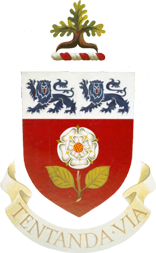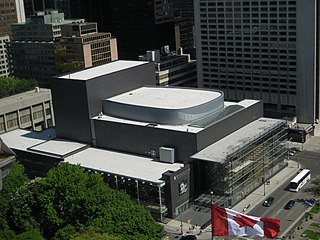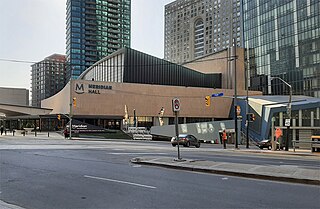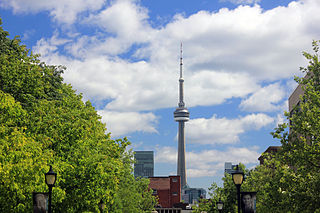
York University, also known as YorkU or simply YU, is a public research university in Toronto, Ontario, Canada. It is Canada's third-largest university, and it has approximately 55,700 students, 7,000 faculty and staff, and over 370,000 alumni worldwide. It has 11 faculties, including the Lassonde School of Engineering, Schulich School of Business, Osgoode Hall Law School, Glendon College, and 28 research centres.

Ontario College of Art & Design University, commonly known as OCAD University or OCAD, is a public art university located in Toronto, Ontario, Canada. The university's main campus is spread throughout several buildings and facilities within downtown Toronto. The university is a co-educational institution which operates three academic faculties, the Faculty of Art, the Faculty of Arts and Science, and the Faculty of Design. The university also provides continuing education services through its School of Continuing Studies.

Osgoode Hall Law School, commonly shortened to Osgoode, is the law school of York University in Toronto, Ontario, Canada. It is home to the Law Commission of Ontario, the Journal of Law and Social Policy, and the Osgoode Hall Law Journal. A variety of LL.M. and Ph.D. degrees in law are available.

The Canadian Opera Company (COC) is an opera company in Toronto, Ontario, Canada. It is the largest opera company in Canada and one of the largest producers of opera in North America. The COC performs at the Four Seasons Centre for the Performing Arts, which was purpose-built for opera and ballet and is shared with the National Ballet of Canada. For forty years until April 2006, the COC had performed at the O'Keefe Centre.

Meridian Hall is a performing arts venue in Toronto, Ontario, and it is the country's largest soft-seat theatre. The facility was constructed for the City of Toronto municipal government and is currently managed by TO Live, an arms-length agency and registered charity created by the city. Located at 1 Front Street East, the venue opened as the O'Keefe Centre on October 1, 1960. From 1996 to 2007, the building was known as the Hummingbird Centre for the Performing Arts. From 2007 to 2019, it was known as the Sony Centre for the Performing Arts. On September 15, 2019, it was re-branded as Meridian Hall.

University Avenue is a major north–south road in Downtown Toronto, Ontario, Canada. Beginning at Front Street West in the south, the thoroughfare heads north to end at College Street just south of Queen's Park. At its north end, the Ontario Legislative Building serves as a prominent terminating vista. Many of Toronto's most important institutions are located along the eight-lane wide street such as Osgoode Hall and other legal institutions, the Four Seasons Centre, major hospitals conducting research and teaching, and landmark office buildings for the commercial sector, notably major financial and insurance industry firms. The portion of University Avenue between Queen Street West and College Street is laid out as a boulevard, with several memorials, statues, gardens, and fountains concentrated in a landscaped median dividing the opposite directions of travel, giving it a ceremonial character.

As the Canadian province with the largest population, Ontario has a particularly prominent role in Canadian music. The provincial capital city of Toronto, Canada's largest municipality, is home to much of the English Canadian music industry and many individual musicians, and the most popular destination for musicians from other parts of Canada, besides French-Canadian musicians, looking to advance their careers. Toronto also supports Canadian music as the centre of English language media in Canada. Hamilton, Ottawa, Kingston and Guelph have also been important centres for Canadian music.

Osgoode is a subway station on Line 1 Yonge–University in Toronto, Ontario, Canada. The station, which opened in 1963, is located under University Avenue where it is crossed by Queen Street West and is named for the nearby Osgoode Hall, which honours William Osgoode, the first chief justice of Upper Canada. Wi-Fi service is available at this station.

Toronto is the largest city in Canada and one of the most multicultural cities in the world. Many immigrant cultures have brought their traditions languages and music to Toronto. Toronto, the capital of the province of Ontario, is a major Canadian city along Lake Ontario's northwestern shore. It's a dynamic metropolis with a core of soaring skyscrapers, all dwarfed by the iconic, free-standing CN Tower. Toronto also has many green spaces, from the orderly oval of Queen's Park to 400-acre High Park and its trails, sports facilities and zoo.
Abel Joseph "Jack" Diamond, was a South African-born Canadian architect. Diamond arrived in Canada in 1964 for the University of Toronto. In 1974, he established his architectural practice, A.J. Diamond Architects. This practice evolved into Diamond Schmitt Architects.

Louis Riel is a three-act opera by composer Harry Somers to an English and French libretto by Mavor Moore and Jacques Languirand. Written for the 1967 Canadian Centennial and arguably that country's most famous opera to date, it portrays the titular Métis leader executed in 1885.

Richard James Bradshaw was a British opera conductor and the General Director of the Canadian Opera Company (COC) in Toronto.

The architecture of Toronto is an eclectic combination of architectural styles, ranging from 19th century Georgian architecture to 21st century postmodern architecture and beyond.

Recreation in Toronto consists of a varied selection of activities and events throughout the city year-round. Toronto boasts renowned theatre and arts communities, has a wide range of recreational public services, and offers many attractions for both residents and tourists.
Canada's National Ballet School, also commonly known as the National Ballet School of Canada, is a classical ballet school located in Toronto, Ontario, Canada. Along with the Royal Winnipeg Ballet School, it is a provider of professional ballet training in Canada. Mavis Staines has been the Artistic Director of the school since 1989.
The St. Lawrence Centre for the Arts is a performing arts theatre complex located in downtown Toronto, Ontario, Canada. Situated on Front Street one block east of Yonge Street, it was the City of Toronto's official centennial project, commemorating the 1967 Canadian Centennial. It houses two auditoriums, the 868-seat Bluma Appel Theatre and the 499-seat Jane Mallett Theatre.
KPMB is a Canadian architecture firm founded by Bruce Kuwabara, Thomas Payne, Marianne McKenna, and Shirley Blumberg, in 1987. It is headquartered in Toronto, where the majority of their work is found. Aside from designing buildings, the firm also works in interior design. KPMB Architects was officially renamed from Kuwabara Payne McKenna Blumberg Architects to KPMB Architects on February 12, 2013.
Taylor Hazell Architects Limited is an architectural firm located in Toronto, Ontario.
James Scott Irvine is a Canadian composer, arranger, and tuba player based in Owen Sound, Ontario. An associate of the Canadian Music Centre and a member of the Canadian League of Composers, he has been commissioned to compose works by the Canadian Broadcasting Corporation, the Laidlaw Foundation, and the Ontario Arts Council. His works have been recorded on a number of commercial releases, including CDs by Joan Watson, Jack Grunsky, the Canadian Chamber Ensemble, and the Berlin Philharmonic. Most of his compositions are written for concert band and brass instruments.
Michael Levine is a Canadian set designer. He is best known for his work in opera, including the scenic design for the Canadian Opera Company's 2006 production of Wagner's Ring Cycle, directed by Atom Egoyan. Levine has also designed productions for Theatre Passe Muraille, Lyric Opera of Chicago, Vienna State Opera, English National Opera, Teatro alla Scala, Dutch National Opera, Royal Shakespeare Company, the Royal Opera House, and the National Theatre.
















